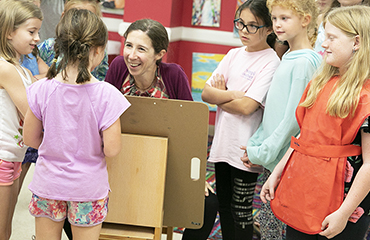
When children hear that Cherry Smith has published two books, they want to know if she's a millionaire. With some difficulty, she explains to them that making money isn't the only reason, or even the main reason, why she writes.
That's not to say that sales have been slow. "Juniper Jupiter" is a Courier Publishing Company bestseller, with about 1,500 copies sold so far. Sales of "Sleepwalk Jones," her recent book, available at Books-a-Million, Barnes and Noble, and Amazon, have also been encouraging.
Smith, who also illustrates her books, was asked what came first, her interest in writing or her interest in art.
"Art, definitely," she said. "I've loved art since the moment when I first had a pencil in my hand."
As a child, she enjoyed the Bible stories that her mother, Judy, read to her and books like "Little Women," by Louisa May Alcott, and "The Polar Express," by Chris Van Allsburg. By the time she was in middle school, she was thinking about writing children's books herself.
"As long as I can remember, that's what I wanted to do," she said.
Children's book publishing is a competitive business, but Smith has some things going for her. For the last nine years, she's been a teacher at Cheerful Cherubs Preschool. For the last 20 years, since she was a high school student, she's kept the nursery on Wednesday nights at First Baptist Church. She has also served as a nanny for both young and older kids, and with the births of twins Charleigh, a girl, and Micah, a boy, she became an aunt.
Being able to try out writing on the intended audience is a huge advantage.
"Children are always honest. They're going to tell you what they think," she said.
Writing a children's story is an exercise in being brief. "You really have to condense it down and get to the essence of it," she said.
"A lot of thought, and a lot of preparation" go into illustrating a children's book, according to Smith. The "storyboards" have to line up, the color schemes have to be consistent, and the pictures have to flow.
"I want the pictures to be as good as the story, and the story to be as good as the pictures. They totally depend on each other," she said.
The two books that Smith has written so far sprang from different impulses. "Juniper Jupiter" is the story of a young girl who "wanted to be the best at everything." She teaches herself how to juggle, but there's a limit to how much even the "world's greatest juggler" can keep going. "One day, her hands that were once so quick lost their grip on all of the things spinning around, and they all came crashing down." Smith says it's a metaphorical representation of the idea that people should concentrate on one thing at a time.
The inspiration for Jeremy, the young protagonist in "Sleepwalk Jones," was a boy Smith met as a teenager during a mission trip to New Orleans, who walked a long way each day, past gangs and other perils, to participate in the activities at the Carver Center, which served as mission headquarters. In Smith's story, Jeremy is transformed into a boy who walks "many miles" every day to school. As he makes his way home through the "dark trees," he begins sobbing, but the sound awakens his grandfather, Sleepwalk Jones, who is napping nearby. Brimming with good cheer, the old man falls in beside him, and Jeremy's day takes a turn for the better.
Girls usually like "Juniper Jupiter" best, and boys like "Sleepwalk Jones." According to Smith, that's by design.
"I wanted them to be completely different, to appeal to a different crowd," she said.
Second books are usually considered easier than the first, but for Smith, that was not the case. "Sleepwalk Jones" was harder, she said, because the Carver Center, where she met Jeremy, was destroyed by Hurricane Katrina in 2005, and because her mother, who helped prepare the manuscript for the book, died in 2014, from complications related to injuries suffered in an automobile accident in 1996. Being "more emotionally attached to the story," she said, made "Sleepwalk Jones" more difficult to do.
Fortunately for Smith, her father, Scott Smith, the director of Lander University's Baptist Collegiate Ministry, has always been an important part of her support system, too. She's thankful, she said, to have had "two wonderful parents who were very involved, who nurtured my love for art, and who encouraged me."
She also credited the visual arts faculty at Lander, from which she graduated in 2006, with helping her develop the skills needed to illustrate children's books. In particular, Alan MacTaggart, emeritus professor of art and former dean of the College of Arts and Humanities, "was a big influence. He's the one who got me involved in painting murals. He's very, very gifted and talented," she said.
Smith is working on a story for preschoolers about a couple of children who get into mischief, inspired by the twins. She would also like to expand upon the characters in "Sleepwalk Jones," and Tumbleweed, the fictional town in which the story is set, in a chapter book for middle-schoolers. The many journals and notebooks that she has accumulated over the years offer other opportunities for development.
Smith considers herself "very blessed." She can't imagine doing anything other than what she's doing.
"If I did something else, I think I would just not be happy, or satisfied," she said.
Seeing her first book in print, she said, was "a dream come true." Now she's published two, with hopes of publishing more.
"So many people live long lives and never get to see that, so I'm very, very fortunate," she said.